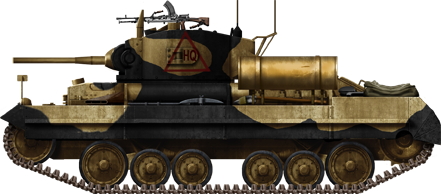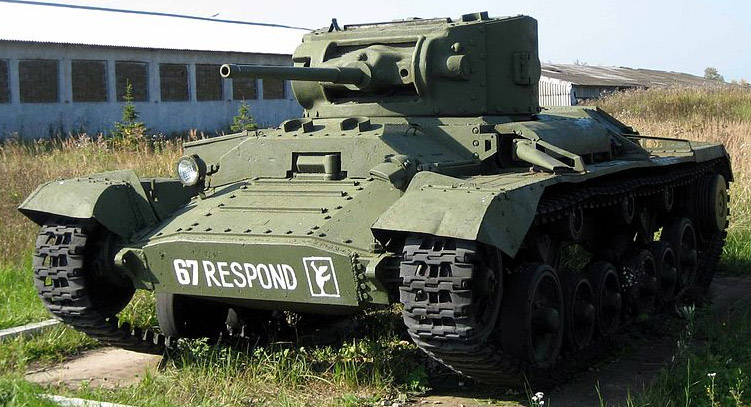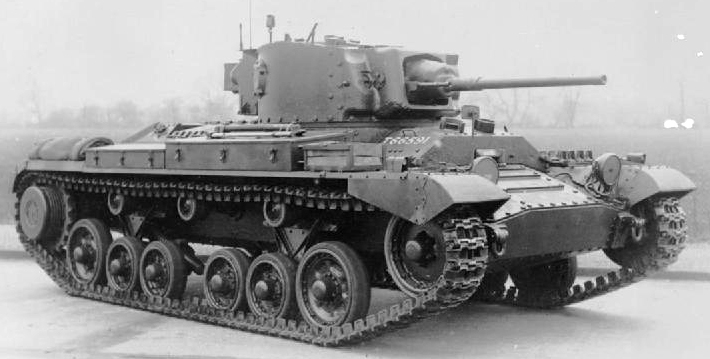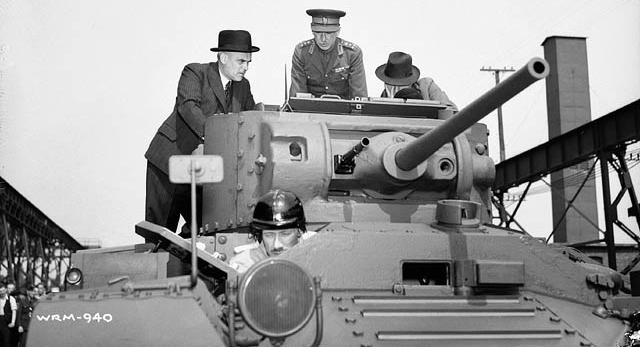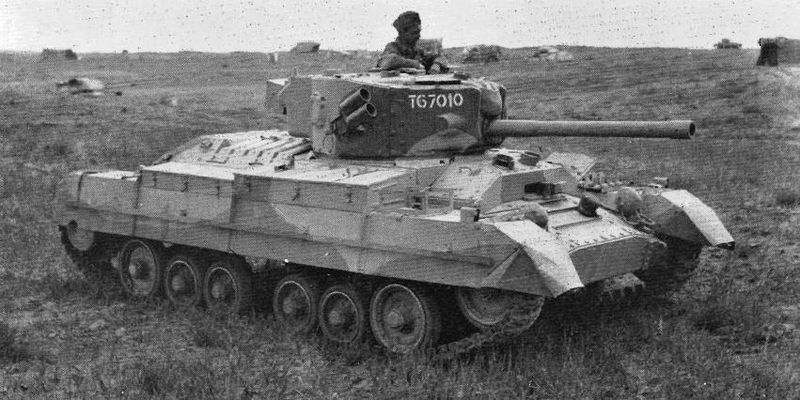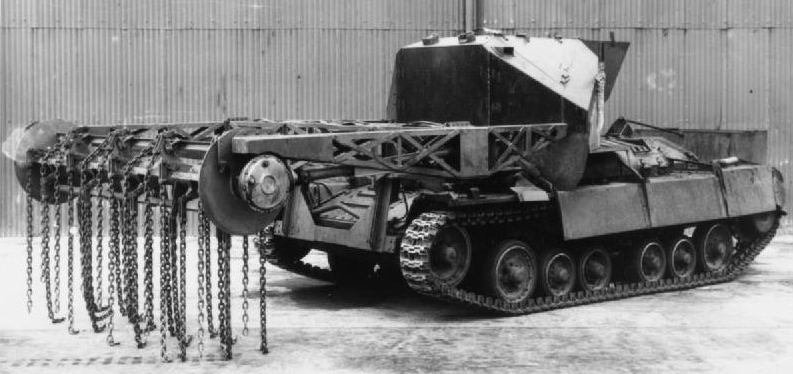Genesis: A cruiser with increased protection
After the A11 Matilda I and A12 Matilda II, the logical choice would be the A13, but that never happened. The Valentine development started without a specification from the War Office (hence the absence of an army designation), as a private design by Sir John Carden, and was submitted on February, 10, 1938, to the authorities. By then, the Matilda II had been chosen for production, but the Valentine was something different.
Vickers engineers basically tried to enhance their A10 Cruiser tank design, with a dramatic increase in protection (up to 60 mm/2.36 in). This choice allowed the use most components and parts of the already produced Cruiser I and II, therefore creating an efficient and cheap solution to the need of new infantry tank models. By then, the Matilda II was found to be far costlier than the Matilda I, and not suitable for mass-production. Comparatively, the Valentine seemed a good compromise. The name itself still is a mystery. It could have originated either from Sir John Carden’s middle name, or the date of its first submission (St. Valentine day), or a composed Vickers factory codename, though most historians agree that Valentine was just a simple codename during development.
Development
Basically, the Valentine’s lower part was almost identical to the A9-A10 Cruiser tank designs. The engine was also the same, as well as the transmission, drivetrain, steering, tracks, and roadwheels, but the upper hull was lowered, and the specially designed turret was more compact and also lowered. This resulted in a compact, if somewhat cramped internally, design, easier to protect. And its armor was massive, although 20 mm (0.79 in) less than the Matilda II, but similar to Matilda I (A11), and much superior to the best German tanks of the time, the Panzer III and IV. The armament was the same puny QF 2-pdr Mk.III(40 mm/1.57 in ), already shared by virtually all British armor.
The War Office was concerned by the size of the turret, which only allowed two men to operate in it. They would have preferred a three-man turret to allow the commander to be fully discharged from other tasks. But, by 1939, war was looming on the backstage of European affairs, and the design was finally approved in a stroke in April, in exchange to fast delivery scheduling. Vickers prepared itself for an order, which came at the end of 1939 with absolute priority, asking for the first deliveries in May 1940. However, by the deadline, the first -and only- prototype was barely on trials. Meanwhile, the evacuation of Dunkirk left Great Britain devoid of any heavy equipment. Mass production started without a pilot or pre-production series, under the denomination of Tank, Infantry, Mark III.
Design
The general layout was straightforward, with a clear compartmentalization in three sections, the driver, fighting and engine compartments. The transmission was short, directly connected to the drive sprockets at the rear, keeping the hull as low as possible. The driver was located at the front center, along with all the steering levers and clutches, which acted on control rods running through the entire length of the hull to the rear gearbox. The driver had good peripheral vision through a direct vision port and two periscopes. Access was possible through two hatches (one per side), and a small escape hatch behind his seat. The early two-man turret had a cylindrical shape, made of rolled plates, with a squared bulkhead protecting the mantlet at the front and a short rear basket.
The gun was positioned just between the gunner (left) and the commander (right), whom also loaded it. When the new turret was introduced with the Mark III, the commander was relocated further back. The manufacturers included the original Vickers-Armstrng factory, Birmingham Railway Carriage & Wagon Co, Metropolitan-Cammell (in three plants), and Canadian Pacific Railway (Angus Shops, Montréal) for Canada.
Production : The Mk.I
The Mark I set the tone for the entire series of eleven main variants, with many sub-variants, and a staggering total of 8300 units. The main armament and turret design, as well as the engine and protection, were continuously improved while keeping roughly the same general appearance until 1945. The Mk.I was recognizable by its original two-man turret and 2-pdr (40 mm/1.575 in) gun. From the start, a coaxial Besa machine-gun constitued the secondary armament. The crew consisted of only three men due to the cramped interior, and the commander was also busy as gun loader, machine-gunner and radio operator. The production was rushed to such point that many problems were later detected and fixed with the next Mk.II. The main engine was the AEG A189 petrol delivering only 135 hp, and the hull was riveted. 350 were delivered in all, most seeing action in Libya, while others stayed at home for training.
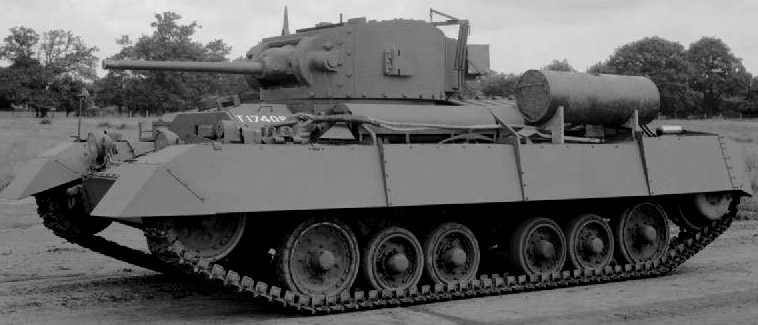
A Mk.II with simple side skirts mounted.
The Mk.II
This version appeared in 1941 and twice as many were completed (700 in all). By June, the “Valentine” was officialized. This version had a 6-cylinder AEC A190 diesel delivering 131 hp, but at lower rate and with more torque, and the autonomy was raised dramatically by adding a left-side external tank (one at the rear was more common practice). This became a trademark of the Valentine.
The Mark III and the three-man turret
The Valentine III appeared in late 1941 and was one of the most produced versions of the entire series. The great improvement came with a completely redesigned turret, with a new internal mantlet and an enlarged turret basket, giving the much needed extra room to accommodate a loader to operate the gun, freeing the commander for other tasks. As a compensation for the added weight, the side armor was somewhat downgraded from 60 to 50 mm (2.36-1.97 in). The main gun was now a QF 2 pounder Mk.V.
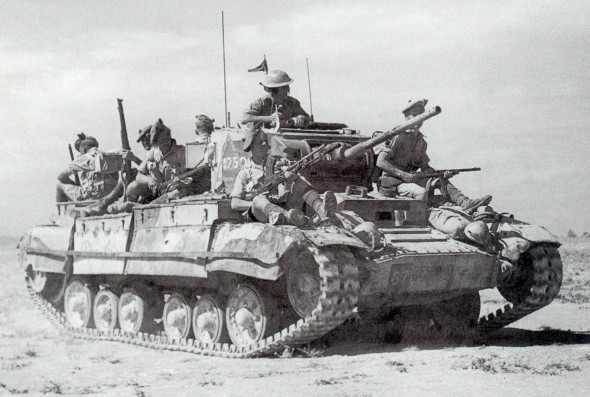
A Mk.III in the Libyan desert, carrying Scottish infantry on its way to the front. Notice the worn-out side skirts.
Mark.IV and V and their US engines
Although similar to the Mk.II, the shortage of British-built engines led to adoption of the US-built GMC (General Motors) engines instead. The Mark IV was equipped with a 138 hp GMC 6004 diesel coupled with an US transmission. Reliability, less vibrations and noise were acquired in the process, which were precious in North Africa, although traded for less range. The Mark V produced in 1942 was virtually identical to the Mark III, but equipped with the same GMC diesel and transmission.
The Canadian Valentines: Mark VI and VII
Both were derived from the Mark IV and were two-man turret models, but with many modifications. The production was set up in 1941 and entered full swing in 1942. These vehicles had more US and Canadian built parts, and the Besa coaxial MG was replaced by the Browning cal.303 (after the 15th delivered). The nose glacis was modified during the production. It was cast rather than assembled in parts, as well as many other parts of the hull and turret. They also shared some components with the Ram. The Mark VII introduced a new N°19 radio set and some internal modifications. The Mark VIA appeared in late 1942 with wider, new studded tracks, jettisonable fuel tanks, an oil cooler and protected headlights. In all, 1420 Canadian Valentines were produced, but they never really incorporated into active Canadian Armoured Divisions, most being retained in Great Britain and at home for training.
The up-gunned Valentines: Mark VIII, IX and X
Since the 2-pounder was found inadequate against the main German tanks of 1942, Vickers engineers worked frantically on a way to adapt the much more massive, long-barrel 6-pounder (57 mm/2.24 in) into the cramped Mark III turret. They succeeded, but at the expense of the coaxial Besa machine-gun. The Mark VIII received the British AEC A190 diesel, but the Mark IX, an upgunned Mark V, retained the US-built GMC 6004 diesel, which was upgraded towards the end of the production in 1942, now giving 160 hp. Both had somewhat downgraded armor. The Mark X was virtually identical to the IX, but at the start incorporated the new GMC diesel, a redesigned turret which reintroduced the coaxial machine-gun, and it used welded construction and some cast parts.
The last Valentine : The elite Mark XI
In 1944, when this model, only produced in small numbers, appeared, they were only given to unit commanders. The Mk.XI had the Mark III three-man turret, and received the long-barrel ROQF 75 mm (2.95 in) gun, basically a 6-pounder (57 mm/2.24 in) rebored to 75 mm (2.95 in). It was also equipped with the latest and most powerful version of the US GMC engine, now giving 210 hp. It had an all-welded construction with many cast parts, including the Canadian design hull nose.
Valentines in action (1941-45)
The Valentine never earned a particular surname, perhaps because it was so commonly seen by troopers. At the same time, the infantry tank Mk.III cumulated some of the usual shortcomings of British tanks, like a cramped turret and interior with small hatches and a partly riveted hull. Most of all, it had the mainstream 2-pounder QF (40 mm/1.57 in) gun, which lacked penetrating power as well as explosive force and concussion (HE shots), despite a good initial velocity. But, at the same time, it was dependable, sturdy, well protected, relatively easy to maintain and, most of all, had a low silhouette, especially compared to the Sherman. They were hard to hit and easy to conceal with a little cover, in any sizable depression in the ground. They showed exceptional endurance. Some Mk.Is and IIs from the VIIIth RTR had roamed 3000 miles of desert before reaching Tunisia in 1943. They were found capable of running 500 miles without maintenance.
The A15 was first called to action in Libya, in mid-1941, when the 8th RTR of the 1st Royal Army took Capuzzo, on 22 November 1941, part of Operation Crusader. Then, most of the eleven marks saw their baptism of fire in the wide expanses of the desert, until the end of the Tunisian campaign. In January 1942 they were found instrumental in support of the 2nd South African Division, in the taking of Bardia. Some (from the 7th RTR) were also trapped in Tobruk and actively took part in the defence of the city. Those of the 23rd Armored Brigade took part in the first battle of El Alamein. At the second battle of El Alamein, the few front-line Valentines were upgunned versions (Mark VII). However, in Sicily and Italy, they arrived in growing numbers. Despite this, the QF 2-pdr stayed the norm for most of the conflict, and, because of this, they were gradually phased out for secondary duties, or were converted for other tasks. Some were stationed in Gibraltar, Madagascar, Malta. In total, the 6th, 8th and 11th Armoured Divisions, as well as the 1st Polish division (trained in Scotland and deployed in Italy 1944-45), were mostly equipped with the Valentine.
In a general way they kept their original assignment as close support infantry tanks, and were seen carrying men to the frontline as improvised APCs. In France, in June 1944, half the Valentines in service were 6-pdr versions, which were found more suitable for frontline action. However, their armor was no match for most of the German tanks of the day. The type was obsolescent by now, and they were definitively withdrawn to second line duties, stationed at the rearguard, sent back to Great Britain for training (like most of the Canadian-built models) or abroad (to serve with ANZAC troops).
In Russian service, the Valentine was one of the preferred “mounts” of Soviet tank crews. They appreciated the low silhouette, reliability and protection, but found the narrow tracks and wheeltrain not adapted to heavy snow, which clogged behind or packed the wheels, and disliked the feeble gun. 2690 were sent in Russia (some Canadian-built), and 400 were lost (sunk) en route to the Northern and Southern front via the Murmansk line, or the Caucasus line, through Iran and the Persian gulf. They were gradually phased out of the frontline and delegated to subsidiary duties in 1943-44.
The New Zealander 3rd Division received many for the 1944 Pacific campaign. They managed to modify many, replacing their main gun with 3 inch (76.2 mm) howitzers from disabled CS versions, and were instrumental in the Burma Campaign until the end of the war. Other users of the Valentine included the Australians (mostly in North Africa), the Poles, and the Free French (a few) in Tunisia and Italy.
Variants
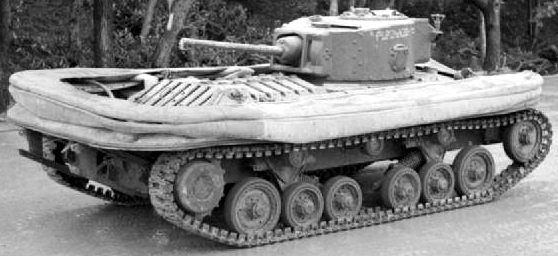
Valentine Mk.V DD, with folded canvas.
Valentine DD
For “Duplex Drive” (kits invented by Nicholas Straussler), one of the famous so-called “Hobart’s funnies” amphibious tanks intended for D-Day. 625 to 635 were converted in 1943-44 by the Metropolitan-Cammell Carriage & Wagon Works Co. Ltd, but they mostly served to train crews for the Sherman DDs, although some saw action in Italy.
Valentine OP
Or “Command Post”, for artillery observation, equipped with a powerful radio kit. The gun was replaced by a dummy.
Valentine CDL
For “Canal Defense Light”. These receive a new turret with a searchlight projector. Experimental only.
Mine-flail versions
Two prototypes were tested, the Valentine Scorpion II and the AMRA Mk.Ib, as well as a few Snake mine-exploders. Some sources stated some 150 used operationally.
Valentine Bridgelayer
A genie turretless version equipped with 34 ft (10 m) long scissor class 30 bridge (30 tons). Around 60 produced, used by nearly all the Allies including the USSR.
Other experiments
One experimented a 6 pdr anti-tank mounting. This was dropped when the new 6-pdr turret finally appeared. Two flamethrower version served as testbeds, in 1942, for the next Churchill Crocodile. Another tested, in 1944, a flame-mortar, firing TNT 25 lbs incendiary shells. The Burmark was a late ramp version scheduled for the Far East, but never produced.
Derivative AFVs
Bishop SPH
The Bishop was developed on the basis of the most sturdy, reliable and common platform available for desert warfare. The goal was to provide quick artillery deployment in the context of fast-moving desert operations in North Africa. The gun was the same standard 25 pdr howitzer (87.3 mm/3.44 in) in use by the Royal artillery, protected by a large fixed enclosed shield. This SPH was produced in only 149 units by the Birmingham Railway Carriage and Wagon Company, in 1942-43, as the Ordnance QF 25-pdr on Carrier Valentine Mk 1, but quickly replaced by the faster M7 Priest.
Archer tank hunter
This unusual vehicle was the first fully indigenous British tank-hunter of the war. It was developed around the excellent AT 17-pdr (76.2 mm/3 in), on a Valentine chassis, by Vickers-Armstrong. Due to the nature of the chassis and the gun, the SP 17 pdr, Valentine, Mk I, Archer was given a rearward-firing configuration. It was seen more like a mobile AT position, and not an active tank-hunter, contrary to the British/US Sherman Firefly. 655 units were delivered, in service in Italy, France and Germany in 1944-45. Some saw action in the Egyptian army during the war of 1956 around the Suez canal.
Links
The Valentine tank on Wikipedia
The Bishop SPH on Wikipedia
The Archer tank destroyer on Wikipedia
Video playlist about the Valentine
The Shadock list of surviving Valentines
| Valentine Mk.II specifications | |
| Dimensions (L/w/h) | 17.9 x 8.7 x 7.5 ft (5.41 x 2.62 x 2.27 m) |
| Total weight, battle ready | 16 long tons (17 short tons) |
| Crew | 3 (commander, driver, gunner) |
| Propulsion | AEC A190 diesel, 160 hp |
| Top speed | 15 mph (24 km/h) |
| Range | 90 mi (140 km) |
| Armament | Main : 1 x QF 2 pdr (40 mm/1.57 in), 90 rounds Sec : 2 x 7.62 mm (0.3 in) BESA machine-guns, 3150 rounds |
| Armor | From 8 to 65 mm (0.31 – 2.56 in) |
| Total production | UK only – 6855 of all versions |
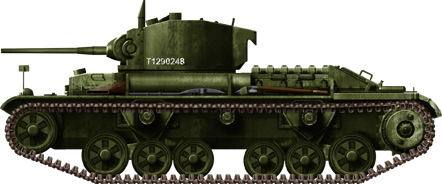
Valentine Mark I, from the first delivered batch, in factory olive green livery, Great Britain, October 1940.
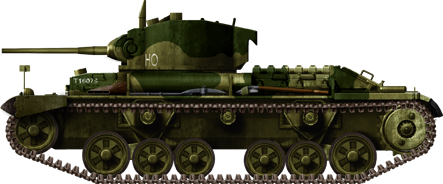
Valentine Mk.I, in the standard homeland camouflage, in February 1941. Many of the 350 Mk.Is built were kept for training.
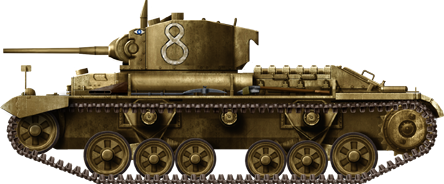
Valentine II in Libya, May 1941. The Valentine came too late for Operation Compass against the Italians, or the ensuing conquest of Libya.
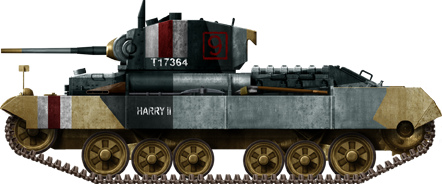
Valentine “Harry II” during Operation Crusader, November 1941.
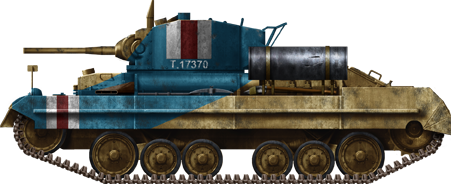
Valentine Mk.II, Operation Crusader, 1st Army Tank Brigade, December 1941.
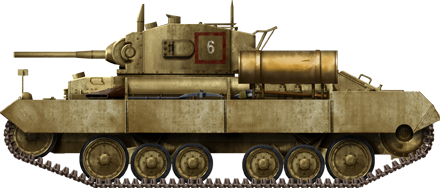
Valentine Mk.II, 40th RTR, Middle East, February 1940.
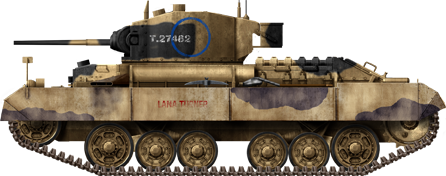
Valentine Mk.II “Lana Turner”, late production version, with the new roadwheels and 2-Pdr Mk.V, from an unidentified unit, Tripoli, January 1943.
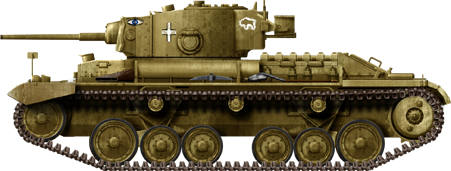
Captured Mk.III, Libya, fall 1942. This version had a better Mk.V 2-pdr and a three-man turret.
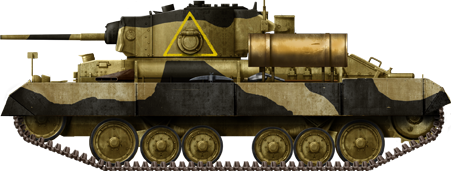
Valentine Mk.III in Tunisia, February 1943.
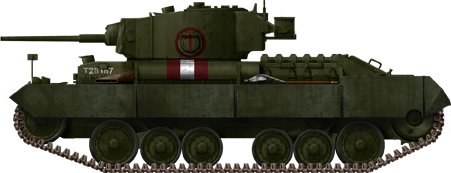
Valentine Mk.III, late production version, Operation Husky, Sicily, July 1943
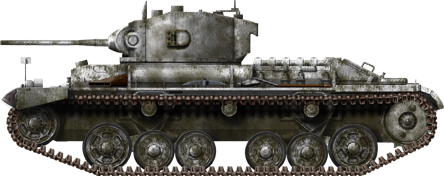
Valentine IV, early production version, battle of Moscow, winter 1941/42.
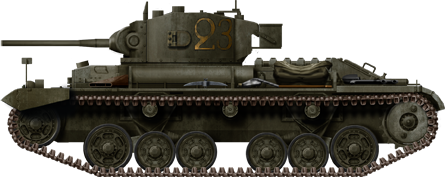
Valentine Mk.IV in Russian service, Northern Front, summer 1943.
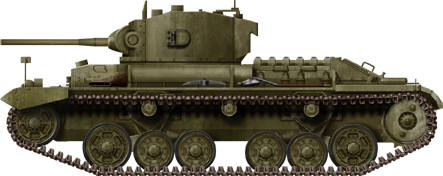
Russian Valentine IV on the Caucasus front, summer 1943. The usual livery was a lighter olive drab.
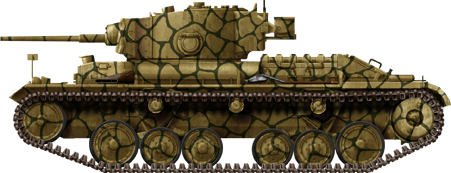
Valentine Mk.V in Malta, fall 1942, with the famous spotted pattern applied to local AFVs.
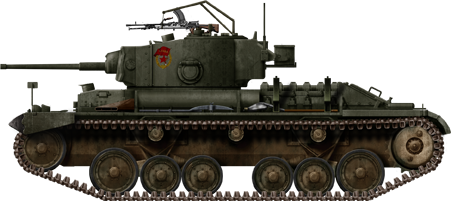
Valentine Mk.V (GCM diesel), Soviet Union, Guard Unit, Northern Front, 1943.
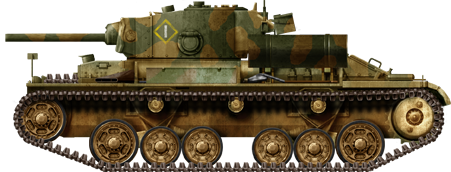
Australian Mk.V CS (Close Support), 3rd Special Tank Squadron, Green Island, Pacific, February 1944.
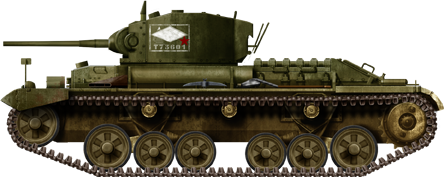
A Canadian-built Mk.VI, early type (1942), in Russian service.
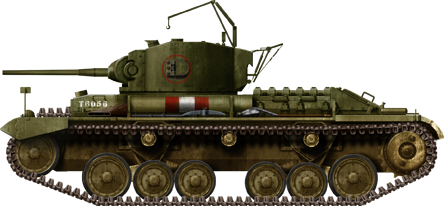
Canadian Mk.VI, Sussex, Great Britain, summer 1943.
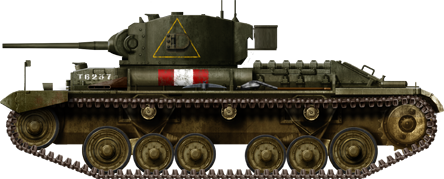
Valentine Mk.VII of the 6th Armoured Division, North Africa 1943. These were manufactured in Montreal and saw action in Tunisia and Italy, but most served for training with the Canadian Armoured Division, ulterior equipped with Shermans.
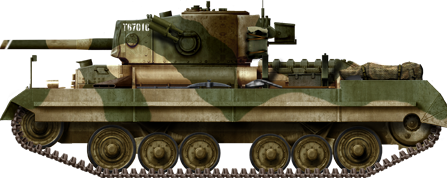
Mk.VIII in Italy, Operation Baytown, VIIIth Army, Salerno, September 1943. The Valentine VIII was the first of the three upgunned late versions, equipped with the standard 6-pdr (57 mm/2.24 in) gun, far more effective against German tanks. But the first versions of the Mk.VIII turret was so cramped that the coaxial Besa machine gun was sacrificed.
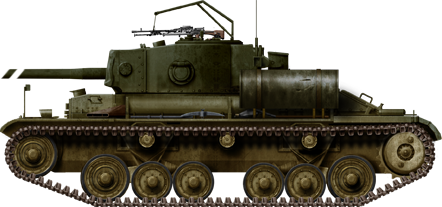
British Valentine Mk.VIII of the VIIIth Army, Italy, 1944.
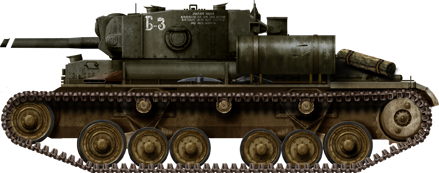
Valentine Mk.IX of the Northern Front, Poland, fall 1944, without front mudguards.
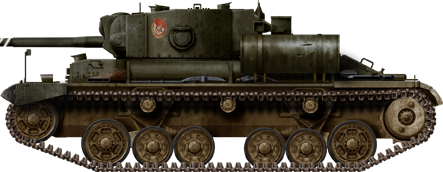
Valentine IX of the Red Guards, Operation Bagration, June 1944.

Valentine Mk.X based in SE Great Britain, used for training Canadian tank crews, May 1944 – super HD picture
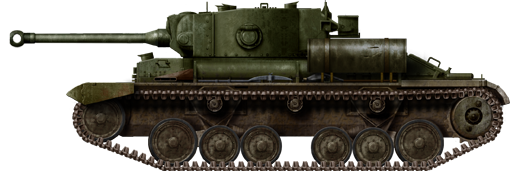
British Valentine Mark XI, a specially equipped version with the 75 mm OQF, only given to tank hunter unit commanders (Archer units), Holland, fall 1944.
Valentine gallery

WW2 Tanks




























WW2 tanks posters

All Tiger tanks liveries.

Panther liveries and variants

WW2 Armour - All tanks











Tanks aces and single tanks series

Find more there

Museums, Movies, Books & Games
The Tanks and Armor in pop culture
Tanks and armored vehicles in general are only really grasped when seen first person: The mass, the scale, it's all there. Explore also the way tanks were covered in the movie industry, in books and in video games.Movies:
Best tanks movie on warhistoryonline.com
On imdb.com
On bestsimilar.com/
miltours.com
liveabout.com/
watchmojo.com
Video Games:
pcgamesn.com
historyhit.com
levvvel.com
vg247.com/best-tank-games
mmobomb.com/
alienwarearena.com


